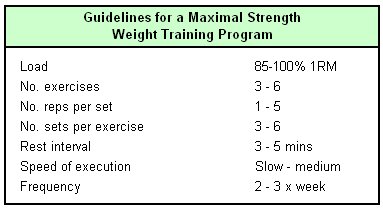These sample weight training programs are designed to develop maximal strength. Training for maximal strength is not the same as training for increased muscle size known as hypertrophy training.
Only relatively few athletes require significant muscle mass and bulk whereas maximal strength is an important fitness component even for classic endurance-type sports. The sport specific approach to strength training article outlines how various types of weight training programs fit together into an overall training plan.
The main objective of maximal strength training is to increase the highest level of force an athlete can generate. Most sports require either explosive power (i.e. sprinting, football, athletic field events) or muscular endurance (i.e. distance running, cycling, rowing) or a combination of the two (i.e. team sports). Explosive power is a combination of strength and speed. Muscular endurance is a combination of strength and endurance. It makes sense then that the greater an athlete’s maximal strength is, the greater the potential for either of these fitness components.
Maximal Strength Training Over Bodybuilding
Maximal strength weight training programs are the only form of training that activates a large number of fast twitch motor units and improves muscle synchronization between the agonists and antagonists – so antagonists don’t oppose the movement (1).
These neuromuscular adaptations plus increases in maximal strength can occur with little or no increase in muscle hypertrophy. This is important for most sports as a high strength to body mass ratio is beneficial (3). Although very large bodybuilders have exceptional muscle mass, their strength is not proportional to their size. Maximal strength training can result in strength gains that are up to 3x greater than the proportional gains in muscular hypertrophy (1).
Hypertrophy is thought to result from a disturbance in the equilibrium between consumption and remanufacture of ATP. This is known as ATP deficiency theory (9). Maximal strength training, with its very high loads, permits only a small number of repetitions to be performed, and coupled with longer rest intervals this prevents ATP deficiency and significant hypertrophy occurring.
Designing Maximal Strength Weight Training Programs
In order to develop maximal strength, relatively heavy loads must be used – greater than 85% one repetition maximum (1RM). This permits only a small number of repetitions, between 1 and 5, per set. Maximal effort is required on each lift and as such this type of training is very taxing. Long rest intervals to allow recovery are required between sets and only a small number of exercises should make up the sessions (2,3,4,5,6,7,8).
To further aid recovery and allow maximal effort to be performed a vertical session design is preferable to a horizontal session design. In other words, one set of each exercise should be performed in sequence and repeated rather than completing all the sets for one exercise before moving on to the next (1).
Even though the bar will move slowly during maximal lifts, the athlete must focus on lifting as explosively as possible in order to recruit the highest number of fast twitch motor units as quickly as possible (1).

Weight training programs designed for maximal strength development should follow a suitable period of basic strength training. Two to three sessions per week is suitable for the pre-season phase and this is often reduced to one or two maintenance sessions during the in-season.
Sample Maximal Strength Weight Training Program
While weight training programs for maximal srength are not as sport-specific as later phases of training, they should still consist of exercises that work the prime movers in the sport or event. The following program is not specific to any sport in particular and works all the major muscle groups in the body. A volleyball player may want to omit bench presses while a badminton player could add barbell lunges for example.

Notice how even though the target load is +85% 1RM this is only achieved in 3 out of the 6 weeks. This stair-stepping approach of gradually increasing the load and then scheduling in a recovery week helps to prevent over-training and allows the athlete to reach a greater peak in performance.
References
1) Bompa TO. 1999 Periodization Training for Sports. Champaign,IL: Human Kinetics
2) Baechle TR and Earle RW. (2000) Essentials of Strength Training and Conditioning: 2nd Edition. Champaign, IL: Human Kinetics
3) Fleck SJ and Kraemer WJ. (2004) Designing Resistance Training Programs: 3rd Edition. Champaign, IL: Human Kinetics
4) Hather BM, Tesch PA, Buchanan P, Dudley GA. Influence of eccentric actions on skeletal muscle adaptations to resistance training. Acta Physiol Scand. 1991 Oct;143(2):177-85
5) McDonagh MJ, Davies CT. Adaptive response of mammalian skeletal muscle to exercise with high loads. Eur J Appl Physiol Occup Physiol. 1984;52(2):139-55
6) Tesch PA, Larsson L. Muscle hypertrophy in bodybuilders. Eur J Appl Physiol Occup Physiol. 1982;49(3):301-6
7) Hedrick A. Training for hypertrophy. Strength Cond. 1995 17(3):22-29
8) Ostrowski KJ, Wilson GJ, Weatherby R, Murphy PW and Lyttle AD. The effect of weight training volume on hormonal output and muscular size and function. J. Strength Cond. Res. 1997 11(3):148-154 9) Hartmann J and Tunnemann H. 1988 Fitness and Strength Training. Berlin:Sportverlag

Jacky has a degree in Sports Science and is a Certified Sports and Conditioning Coach. He has also worked with clients around the world as a personal trainer.
He has been fortunate enough to work with a wide range of people from very different ends of the fitness spectrum. Through promoting positive health changes with diet and exercise, he has helped patients recover from aging-related and other otherwise debilitating diseases.
He spends most of his time these days writing fitness-related content of some form or another. He still likes to work with people on a one-to-one basis – he just doesn’t get up at 5am to see clients anymore.